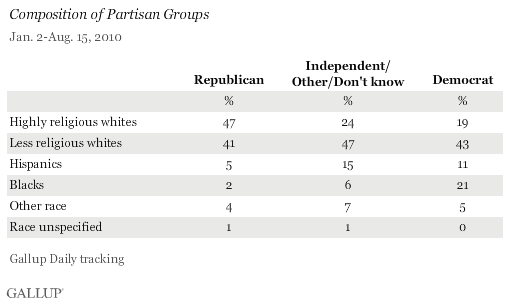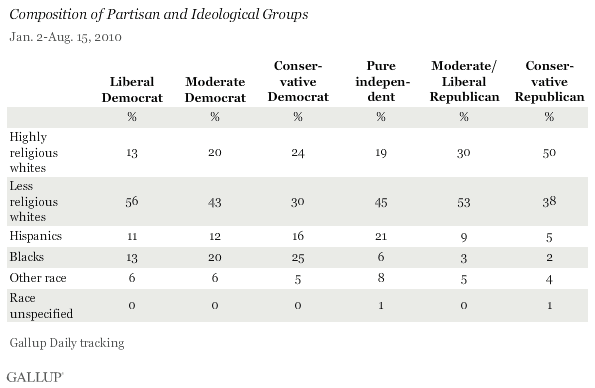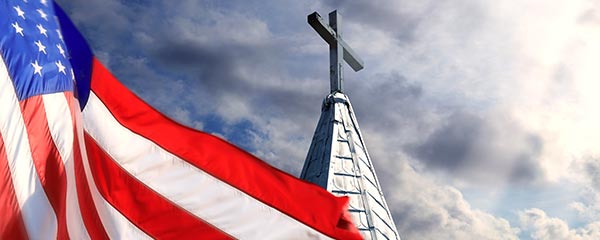PRINCETON, NJ -- About 9 out of 10 Republicans are non-Hispanic whites, and more than half of these are highly religious. That compares with 62% of the Democratic rank-and-file that is white and largely less religious, with blacks and Hispanics making up a much more substantial part of that party's base.

These results are based on aggregated data from more than 220,000 Americans surveyed from early January through Aug. 15 of this year as part of Gallup Daily tracking. Whites classified as highly religious are those who say religion is important in their daily lives and who report attending religious services weekly or almost every week. Hispanics include everyone who identifies as Hispanic, regardless of race.
The mixture of religion and politics in the United States came to the fore again this past weekend at Glenn Beck's high-visibility "Restoring Honor" rally in Washington, D.C. Beck mentioned God and religion frequently in his remarks. The rally was billed as nonpolitical, but the presence of former vice presidential candidate Sarah Palin, Beck's involvement with the politically oriented Tea Party movement, and Beck's own avowedly conservative persona and positions on the issues brought a political perspective to the event.
Gallup Daily tracking data reviewed in this analysis confirm that religion, along with race, is a significant factor in defining Republicans, independents, and Democrats. Eighty-eight percent of Republicans are white, compared with 71% of independents and 62% of Democrats. The majority of white Republicans are highly religious, while the substantial majority of white Democrats are less religious.
All in all, 47% of Republicans in the U.S. today can be classified as highly religious whites, compared with 24% of independents and 19% of Democrats.
Religious distinctions in the American political landscape today are underscored when one examines the political spectrum by both party and ideology. The percentage of highly religious white Americans within each of the resulting political groups ranges from a high of 50% among conservative Republicans to 13% among liberal Democrats.

Of note is the substantial difference in the religious composition of conservative and moderate/liberal Republicans. White conservative Republicans are more likely to be highly religious than less religious, while white moderate/liberal Republicans are more frequently in the latter category. In similar but less dramatic fashion, both conservative and moderate/liberal white Democrats are more likely to be highly religious than are liberal white Democrats, although in all Democratic groups, less religious whites predominate over highly religious whites.
Implications
Americans who identify as Republicans in America today, particularly those who identify as conservative Republicans, are disproportionately likely to be highly religious whites, in contrast with both the population as a whole and the other political segments. Republicans are not monolithically white and religious, however; half are either less religious whites or people of other racial or ethnic groups. But conservative Republicans have the highest proportion of religious whites of any of the six major partisan/ideological groups -- including almost four times as many on a proportionate basis as is the case among liberal Democrats -- which highlights the significance of religion in today's political landscape.
Results are based on telephone interviews conducted as part of Gallup Daily tracking Jan. 2-Aug. 15, 2010, with a random sample of 222,743 adults, aged 18 and older, living in all 50 U.S. states and the District of Columbia, selected using random-digit-dial sampling.
For results based on the total sample of national adults, one can say with 95% confidence that the maximum margin of sampling error is ±1 percentage point.
The analysis of party and ideology are based on a total sample of 113,533 adults, aged 18 and older; for this sample, one can say with 95% confidence that the maximum margin of sampling error is ±1 percentage point.
Interviews are conducted with respondents on landline telephones and cellular phones, with interviews conducted in Spanish for respondents who are primarily Spanish-speaking. Each daily sample includes a minimum quota of 150 cell phone respondents and 850 landline respondents, with additional minimum quotas among landline respondents for gender within region. Landline respondents are chosen at random within each household on the basis of which member had the most recent birthday.
Samples are weighted by gender, age, race, Hispanic ethnicity, education, region, adults in the household, cell phone-only status, cell phone-mostly status, and phone lines. Demographic weighting targets are based on the March 2009 Current Population Survey figures for the aged 18 and older non-institutionalized population living in U.S. telephone households. All reported margins of sampling error include the computed design effects for weighting and sample design.
In addition to sampling error, question wording and practical difficulties in conducting surveys can introduce error or bias into the findings of public opinion polls.
For more details on Gallup's polling methodology, visit https://www.gallup.com/.
